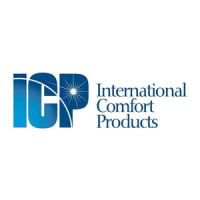
Do you have a question about the ICP EF08B1500A1 and is the answer not in the manual?
Defines signal words DANGER, WARNING, and CAUTION for hazard identification.
Explains the usage of WARNING and CAUTION signal words in manuals and on product labels.
Emphasizes hazards from unqualified persons, failure to follow instructions, and fire risk.
Guidance on selecting the best position for unit installation considering space and access.
Unit ready for upflow; must be supported on the bottom. Downflow requires Subbase Kit.
Cabinet can be placed on either side for horizontal airflow, with or without a coil.
Auxiliary drain pan required for installations over finished living space or areas prone to damage.
Steps for installing horizontal drain pan, coil support, and drip flanges.
Guidance on suspending the cabinet using strapping or threaded rod with angle iron supports.
Connect supply duct to the outlet flange and return duct to the unit bottom.
Filters are field supplied; options include internal, remote, or washable filters.
Instructions for removing the filter door and sliding the filter into the unit.
Connect 3/4" NPT fittings, trap, and pitch lines down. Insulate where sweating may occur.
Requires a secondary overflow drain connection to prevent water on electrical components.
Connect to waste line with an air gap and trap to prevent sewer gases.
Factory installed restrictor may need changing for best performance; refer to charts.
Instructions for removing and replacing the restrictor orifice in the liquid line fitting.
Size lines per outdoor unit info; route to avoid service access obstruction.
Turn OFF power before electrical connections; ensure proper ground connection.
All electrical work must conform with local codes and the National Electrical Code.
Connect field wiring at the control board terminals; keep low voltage wiring short.
Bring line voltage through top right or right side panel; locate disconnect switch within sight.
Locate adapter and filler plates, attach them, secure kit with screws, and connect wiring.
Table detailing supply circuit, motor amps, branch circuit, and recommended wire size.
Disconnect black wire at terminal block and reconnect at desired blower speed tap.
Measure external static pressure to determine speed tap for 350-450 cfm per ton.
Clean filters when dirty, inspect monthly. Clean filters maintain unit efficiency.
The bearings of the blower motor are permanently lubricated.
Check drain lines for flow, ensure primary drain is not blocked.
Tables showing CFM at various static pressures for different models and speeds.
Table listing filter sizes and corresponding static pressure drop values.
Describes fan and heat stage control based on thermostat calls.
Operation sequences for cooling and heating modes with electric heat.
Operation sequences for heat pump cooling, heating, and emergency heat.
Response to over-temperature conditions, including soft and hard lockout.
Diagram for base unit with No-Heat Kit, including fan control and transformer connections.
Diagrams for various electric heater capacities (5kW to 30kW) with limit controls.
Diagram showing the location of various parts within the blower coil unit.
Table listing part numbers, descriptions, and applicability for different models.
